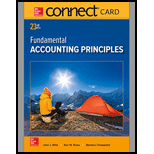
Concept Introduction:
Financial Statements: Financial statements are reports of the financial condition of a company or entity. In the financial statements, the management presents the financial performance and position of the company at a point in time. Financial statements disclose the financial effects of business transactions. Financial statements include a
Balance Sheet: Balance sheet provides details of firm’s assets, liabilities and owner’s equity for a given date. The Balance sheet gives a snapshot of what the company owns and owes as well as the amount invested in equity. The Balance sheet follow the below rule
Assets = Liabilities + equity
Income Statement: It is also called profit & loss statement. Income statement provides a snapshot of revenue, expenses and net income of the organization for a given period.
Statement of Cash Flows: It is a financial statement that shows the movements of cash and Bank balance during a period. It describes the amount of cash generated by the company during a period and the use of the cash.
1.
To determine: The following about company V.
a. Amount of equity as on December 31, 2016.
b. Amount of equity as on December 31, 2017.
c. Net income or loss for the year 2017.
Explanation of Solution
The amount of equity and net income or loss, about company V is as below:
a. Amount of equity as on December 31, 2016 = $29,000
b. Amount of equity as on December 31, 2017=$23,000
c. Net income or loss for the year 2017 is the loss of $5,500.
2.
The following about company W.
a. Amount of equity as on December 31, 2016.
b. Amount of equity as on December 31, 2017.
c. Amount of liabilities as on December 31, 2017.
Explanation of Solution
The amount of equity and liabilities, about company W is as below:
a. Amount of equity as on December 31, 2016 = $20,000
b. Amount of equity as on December 31, 2017=$78,000
c. Amount of liabilities as on December 31, 2017 is $22,000
3.
To Compute: The amount of owner investment for company X during 2017.
Explanation of Solution
The amount of owner investment for company X during 2017 is $29,200
Calculations:
Amount of equity on December 2016 = Assets - Liabilities
Amount of equity on December 2017 = Assets - Liabilities
Owner investment = Closing equity opening equity Net income cash withdrawals
4.
To Compute: The amount of assets for company Y on December 31, 2017.
Explanation of Solution
The amount of assets for company Y on December 31, 2017, is $135,100
Calculations:
Amount of equity on December 2016 = Assets - Liabilities
Amount of equity on December 2017 =
Assets on December 31, 2017
5.
To Compute: The amount of liabilities for company Z on December 31, 2016.
Explanation of Solution
The amount of liabilities for company Z on December 31, 2016, is $100,000.
Calculations:
Amount of equity on December 2017
Amount of equity on December 2016 =
Liabilities on December 31, 2016
Want to see more full solutions like this?
Chapter 1 Solutions
Connect Access Card for Fundamental Accounting Principles

 AccountingAccountingISBN:9781337272094Author:WARREN, Carl S., Reeve, James M., Duchac, Jonathan E.Publisher:Cengage Learning,
AccountingAccountingISBN:9781337272094Author:WARREN, Carl S., Reeve, James M., Duchac, Jonathan E.Publisher:Cengage Learning, Accounting Information SystemsAccountingISBN:9781337619202Author:Hall, James A.Publisher:Cengage Learning,
Accounting Information SystemsAccountingISBN:9781337619202Author:Hall, James A.Publisher:Cengage Learning, Horngren's Cost Accounting: A Managerial Emphasis...AccountingISBN:9780134475585Author:Srikant M. Datar, Madhav V. RajanPublisher:PEARSON
Horngren's Cost Accounting: A Managerial Emphasis...AccountingISBN:9780134475585Author:Srikant M. Datar, Madhav V. RajanPublisher:PEARSON Intermediate AccountingAccountingISBN:9781259722660Author:J. David Spiceland, Mark W. Nelson, Wayne M ThomasPublisher:McGraw-Hill Education
Intermediate AccountingAccountingISBN:9781259722660Author:J. David Spiceland, Mark W. Nelson, Wayne M ThomasPublisher:McGraw-Hill Education Financial and Managerial AccountingAccountingISBN:9781259726705Author:John J Wild, Ken W. Shaw, Barbara Chiappetta Fundamental Accounting PrinciplesPublisher:McGraw-Hill Education
Financial and Managerial AccountingAccountingISBN:9781259726705Author:John J Wild, Ken W. Shaw, Barbara Chiappetta Fundamental Accounting PrinciplesPublisher:McGraw-Hill Education





